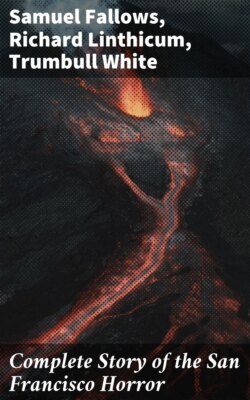Читать книгу Complete Story of the San Francisco Horror - Fallows Samuel - Страница 16
На сайте Литреса книга снята с продажи.
ОглавлениеCopyright 1906, by American-Journal-Examiner. All rights reserved. Any infractions
of this copyright will be prosecuted to the full extent of the law.
VIEW FROM VALLEY STREET.
This is a view from Valley Street looking down Kearney toward Market.
Copyright 1906, by American-Journal-Examiner. All rights reserved. Any infractions
of this copyright will be prosecuted to the full extent of the law.
DESTROYED WHOLESALE HOUSES.
This photograph shows the wreck and ruin wrought by the earthquake and fire in the wholesale district.
But the sacrifice and the labor went for nothing. No human power could stay the flames. As darkness was falling the fire was eating its way through the heart of this residential district. The mayor was forced to announce that the last hope had been dashed.
All the district bounded by Union, Van Ness, Golden Gate, to Octavia, Hayes, and Fillmore to Market was doomed. The fire fighters, troops, citizens, and city officials left the scene, powerless to do more.
On the morning of the second day when the fire reached the municipal building on Portsmouth square, the nurses, helped by soldiers, got out fifty bodies in the temporary morgue and a number of patients in the receiving hospital. Just after they reached the street a building was blown up and the flying bricks and splinters hurt a number of the soldiers, who had to be taken to the out of doors Presidio Hospital with the patients.
Mechanics’ pavilion, which, after housing prize fights, conventions, and great balls, found its last use as an emergency hospital. When it was seen that it could not last every vehicle in sight was impressed by the troops, and the wounded, some of them frightfully mangled, were taken to the Presidio, where they were out of danger and found comfort in tents.
The physicians worked without sleep and almost without food. There was food, however, for the injured; the soldiers saw to that. Even the soldiers flagged, and kept guard in relays, while the relieved men slept on the ground where they dropped.
The troops shut down with iron hands on the city, for where one man was homeless the first night five were homeless the second night. With the fire running all along the water front, few managed to make their way over to Oakland. The people for the most part were prisoners on the peninsula.
The soldiers enforced the rule against moving about except to escape the flames, and absolutely no one could enter the city who once had left.
The seat of city government and of military authority shifted with every shift of the flames. Mayor Schmitz and General Funston stuck close together and kept in touch with the firemen and police, the volunteer aids, and the committee of safety through couriers.
There were loud reverberations along the fire line at night. Supplies of gun cotton and cordite from the Presidio were commandeered and the troops and the few remaining firemen made another futile effort to check the fiery advance.
Along the wharves the fire tugs saved most of the docks. But the Pacific mail dock had been reached and was out of control; and finally China basin, which was filled in for a freight yard at the expense of millions of dollars, had sunk into the bay and the water was over the tracks. This was one of the greatest single losses in the whole disaster.
Without sleep and without food, crowds watched all night Wednesday and all day Thursday from the hills, looking off toward that veil of fire and smoke that hid the city which had become a hell.
Back of that sheet of fire, and retreating backward every hour, were most of the people of the city, forced toward the Pacific by the advance of the flames. The open space of the Presidio and Golden Gate park was their only haven and so the night of the second day found them.
